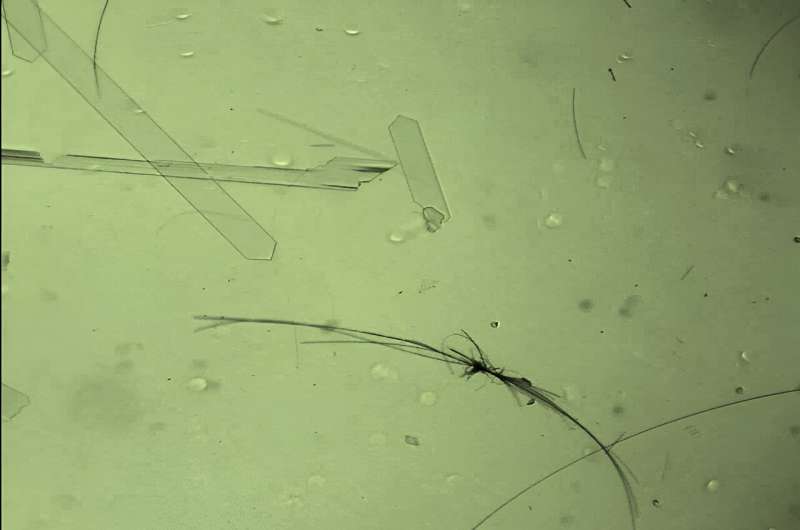This article has been reviewed according to Science X's editorial process and policies. Editors have highlighted the following attributes while ensuring the content's credibility:
fact-checked
trusted source
proofread
Molecular crystal motors move like microbes when exposed to light

At first glance, Rabih O. Al-Kaysi's molecular motors look like the microscopic worms you'd see in a drop of pond water. But these wriggling ribbons are not alive; they're devices made from crystallized molecules that perform coordinated movements when exposed to light. With continued development, Al-Kaysi and colleagues say, their tiny machines could be used by physicians as drug-delivery robots or engineered into arrays that direct the flow of water around submarines.
The researchers will present their results today at the spring meeting of the American Chemical Society (ACS).
The team built their initial molecular crystal motor in 2021 with molecules that enabled photoisomerization—simply put, the individual molecules in the motor wave one of their chemical groups back and forth when exposed to light, and their collective motion results in visible movement of the motor itself.
"Our first motor was a microwire that bent and fluttered when I exposed it to a combination of UV and visible light," says Al-Kaysi. "It looked like a ribbon dancer. It looked alive."
The molecules in the team's first motor needed several wavelengths of light (UV and visible) to drive photoisomerization. However, Al-Kaysi and colleague Christopher Bardeen wanted to create molecular crystal motors that only needed a single wavelength of light to run. So, they synthesized a library of light-absorbent anthracene molecules capable of non-stop back-and-forth movement—i.e., continuous photoisomerization—with a single light source.
The researchers are in the process of characterizing the anthracene-based molecules and using them as building blocks to create more molecular crystal motors. Their light-activated menagerie now includes long snake-like ropes and one very hairy spider that can bend, jump, twist and dance.
Al-Kaysi, an organic chemist at King Saud bin Abdulaziz University for Health Sciences and King Abdullah International Medical Research Center, has worked with Bardeen, a professor of chemistry at the University of California, Riverside, for more than two decades on photomechanical crystals.
These "smart" crystals convert energy they absorb from light into mechanical work and are typically characterized as thermally reversible or photochemically reversible. In other words, the crystals' initial movement in response to light stimulus is reversed with a second stimulus of heat or light, respectively. However, a third subset of these smart crystals is getting more attention from chemists like Al-Kaysi and Bardeen because of their ability to sustain continuous, oscillating movement when exposed to a single light source.
The photoreactive molecules in Al-Kaysi's library are the starting point for making molecular crystal motors. Each of the molecules contains three segments: an anthracene segment, a carbon double bond and a customizable "headgroup" on the other side of the carbon bond. The anthracene absorbs light and transmits the energy to the carbon double bond, which acts as the molecule's axle. Then the headgroup determines the molecule's crystal-packing structure, shape and behavior.
Once the anthracene molecules are synthesized, they are injected into a soapy solution where they pack together in a process called crystal engineering. These crystallized clumps are used as "seeds" and are placed into another soapy solution with more of the anthracene molecules where they self-assemble into larger shapes—typically rods and wires.
Some of these structures self-assemble into even more complex shapes that are visible with the naked eye. While the motor self-assembly is mostly random, the researchers are looking for ways to direct it by varying the temperature and soapiness of the liquid and by stirring the liquid at different speeds.
When illuminated in their soapy solution, the motors display intricate and continuous 3D motion. The researchers can tune a motor's movement by adjusting light intensity and wavelength. On a molecular level, the movement is driven by photoisomerization around the carbon double bond, the researchers know. However, they are still investigating how the molecules coordinate this behavior over the entire molecular crystal motor.
In demonstrations, the researchers found that the motors are remarkably durable, showing no signs of fatigue after hours of light exposure. And because they are crystal-based, they have an innate resistance to corrosion and electromagnetic interference and offer an "exceptional" weight-to-power ratio. According to the researchers, these qualities make the molecular crystal motors particularly suitable for biomedical applications, micromachines and microsatellites.
Al-Kaysi and Bardeen say that with the help of an "engineer's touch," their basic science discoveries have the potential to solve real-world problems, like light-activated molecular machines for drug delivery and arrays that direct the flow of water around a ship's hull.
Provided by American Chemical Society





















